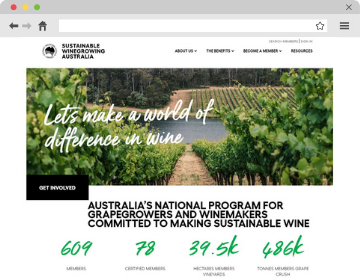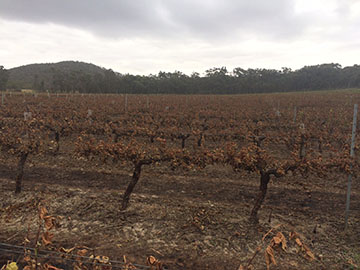A new look and website for Sustainable Winegrowing Australia
Preparations underway for National Wine Sector Bushfire Conference
Towards a rapid test for smoke
Grant to develop biosensor for smoke analysis
Order the latest staff publications online
A new look and website for Sustainable Winegrowing Australia |
|
 |
A refreshed website has just been launched for Sustainable Winegrowing Australia – the national sustainability program for Australia’s grapegrowers and winemakers. Visit http://www.sustainablewinegrowing.com.au to learn more about the program and the benefits of membership. If you’ve been thinking about joining, don’t hesitate! Sign up here to receive a short email series with tips for how you can benefit from becoming more sustainable and prepare yourself for membership. If you would like to speak to someone about Sustainable Winegrowing Australia, contact the AWRI helpdesk on helpdesk@awri.com.au or 08 8 313 6600. |
Preparations underway for National Wine Sector Bushfire ConferenceA number of AWRI staff are preparing to take part in the National Wine Sector Bushfire Conference on 25 May. Managing Director, Dr Mark Krstic will provide a national overview of the fires that occurred during the 2020 vintage and their impact. Dr Eric Wilkes will describe techniques used for testing grapes and wines for smoke and comparative results between different laboratories. Damian Espinase Nandorfy will discuss smoke taint sensory evaluation, including good practices to improve the rigour and reliability of in-the-field assessments. Dr Mango Parker will provide the latest results from her research on the impacts of early-season smoke exposure. This free conference coordinated by Wine Australia, Australian Grape & Wine, ASVO and the AWRI. will cover bushfire preparedness, smoke effects and recovery from fire to ensure that grapegrowers, winemakers and businesses are better prepared for future bushfires. The National Wine Sector Bushfire Conference will be held at locations in Hahndorf, Sydney, Wangaratta, Stanthorpe, Hobart and South Perth. Register now: wineaustralia.com/national-wine-sector-bushfire-conference. |
|
Water management resourcesWater is a valuable and limited resource for grapegrowers. To support growers to manage their irrigation water most effectively, the AWRI has developed a new water management webpage. Visit http://www.awri.com.au/industry_support/viticulture/water-management/ to access a wide range of resources on topics including vineyard water use efficiency, water management plans, irrigation scheduling and irrigation system monitoring and maintenance. The webpage will also be updated regularly with activities and resources developed as part of an irrigation efficiency practice change project being conducted by the AWRI, in collaboration with Wine Australia and the inland irrigated wine-growing regions. For more information, contact the AWRI helpdesk on 08 8 313 6600 or helpdesk@awri.com.au. |
|
Towards a rapid test for smoke |
|
 |
Testing grapes or wine for evidence of smoke exposure involves the use of complex analytical instruments to determine the concentration of a range of volatile phenols and glycosides. Interpretation of results then requires comparison with background levels of these compounds in non-smoke-exposed grapes. Overall, this requires a relatively high level of technical expertise and it can take around 10 days before results are available. A rapid screening test that could be used to determine the impact of smoke exposure would therefore be extremely valuable for the wine industry. AWRI Commercial Services has recently completed a project investigating the potential for using mid-infra-red spectroscopy to perform rapid screening for smoke compounds. The work was published in the Autumn 2021 issue of Wine & Viticulture and is available online here: A burning need: developing a rapid screening method for smoke-affected grapes and wine. |
Grant to develop biosensor for smoke analysisThe AWRI is a partner in a collaborative project, with QUT and CSIRO, that has recently been awarded an Australian Research Council Linkage Grant to develop protein-based biosensors for phenolic glycosides. The goal is to generate selective biosensors and devise a simple portable test for smoke compounds that can be performed in the vineyard or the winery. This is the first time this type of technology will be applied to a problem in the wine industry. For more information, visit: https://www.qut.edu.au/research/article?id=174988 |
|
Order the latest staff publications onlineAccessing the latest AWRI publications is easy. Visit the AWRI Publications web page to:
The AWRI’s most recent publications are listed below. 2214 Essling, M. Ask the AWRI: Use of elicitors in viticulture. Aust. N.Z. Grapegrower Winemaker (686) : p. 35; 2021. 2215 Varela, C., Bartel, C., Espinase Nandorfy, D., Bilogrevic, E., Tran, T., Heinrich, A., Balzan, T., Bindon, K., Borneman, A. Volatile aroma composition and sensory profile of Shiraz and Cabernet Sauvignon wine produced with novel Metschnikowia pulcherrima yeast starter cultures. Aust. J. Grape Wine Res. doi:10.1111/ajgw.12484: 1-13; 2021. 2216 Mierczynska-Vasilev, A., Bindon, K., Gawel, R., Smith, P., Vasilev, K., Butt, H-J., Koynov, K. Fluorescence correlation spectroscopy to unravel the interactions between macromolecules in wine. Food Chem. 352: 129343; 2021. 2217 Scrimgeour, N., Hirlam, K., Wilkes, E., Parker, M. A burning need: developing a rapid screening method for smoke-affected grapes and wine. Wine Vitic. J. 36(2): 33-35; 2021. 2218 Roach, M., Borneman, A., Schmidt, S., Krstic, M. Applying genomics to grapevine clones. Wine Vitic. J. 36(2): 39-41; 2021. 2219 Dry, P. Blaufränkisch. Wine Vitic. J. 36(2): p. 59; 2021. 2220 Day, M.P., Espinase Nandorfy, D., Bekker, M.Z., Bindon, K.A., Solomon, M., Smith, P.A., Schmidt, S.A. Aeration of Vitis vinifera Shiraz fermentation and its effect on wine chemical composition and sensory attributes. Aust. J. Grape Wine Res. doi: 10.1111/ajgw.12490; 2021. 2221 Zhou-Tsang, A., Wu, Y., Henderson, S.W., Walker, A.R., Borneman, A.R., Walker, R.R., Gilliham, M. Grapevine salt tolerance. Aust. J. Grape Wine Res. 27(2): 149-168; 2021. 2222 Cowey, G. Ask the AWRI: How much sulfur dioxide (SO2) is needed at bottling? Aust. N.Z. Grapegrower Winemaker (687): 76-77; 2021. 2223 Capone, D.L., Barker, A., Pearson, W., Francis, I.L. Influence of inclusion of grapevine leaves, rachis and peduncles during fermentation on the flavour and volatile composition of Vitis vinifera cv. Shiraz wine. Aust. J. Grape Wine Res. doi: 10.1111/ajgw.12489; 2021. 2224 Teng, B., Hayasaka, Y., Smith, P.A., Bindon, K.A. Precipitation of tannin-anthocyanin derivatives in wine is influenced by acetaldehyde concentration and tannin molecular mass with implications for the development of nonbleachable pigments. J. Agric. Food Chem. 69(16): 4804-4815; 2021. |
|
AcknowledgementsThe AWRI acknowledges support from Australia’s grapegrowers and winemakers through their investment body, Wine Australia, with matching funds from the Australian Government. The AWRI is a member of the Wine Innovation Cluster in Adelaide, South Australia. |
|

